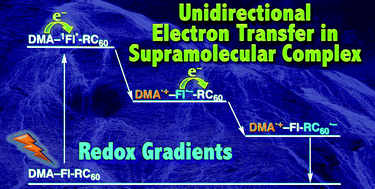Implementation of redox gradients in hydrogen bonded complexes containing N,N-dimethylaniline, flavin and fullerene derivatives†
Abstract
A variety of supramolecular complexes were formed by associating an

* Corresponding authors
a
Department of Material and Life Science, Division of Advanced Science and Biotechnology, Graduate School of Engineering, Osaka University, SORST, Japan Science and Technology Agency (JST), Suita, Osaka, Japan
E-mail:
fukuzumi@chem.eng.osaka-u.ac.jp
Fax: +81 6 6879 7370
Tel: +81 6 6879 7368
b School of Materials Science, Japan Advanced Institute of Science and Technology (JAIST) and PRESTO, JST, Nomi, Ishikawa, Japan
c
Physical Chemistry and Interdisciplinary Center for Molecular Materials (ICMM), FAU Erlangen-Nürnberg, Erlangen, Germany
E-mail:
guldi@chemie.uni-erlangen.de
d Organic Chemistry and Interdisciplinary Center for Molecular Materials (ICMM), FAU Erlangen-Nürnberg, Erlangen, Germany
e Department of Bioinspired Science, Ewha Womans University, Seoul, Korea
A variety of supramolecular complexes were formed by associating an

 Please wait while we load your content...
Something went wrong. Try again?
Please wait while we load your content...
Something went wrong. Try again?
M. Murakami, K. Ohkubo, T. Hasobe, V. Sgobba, D. M. Guldi, F. Wessendorf, A. Hirsch and S. Fukuzumi, J. Mater. Chem., 2010, 20, 1457 DOI: 10.1039/B918462G
To request permission to reproduce material from this article, please go to the Copyright Clearance Center request page.
If you are an author contributing to an RSC publication, you do not need to request permission provided correct acknowledgement is given.
If you are the author of this article, you do not need to request permission to reproduce figures and diagrams provided correct acknowledgement is given. If you want to reproduce the whole article in a third-party publication (excluding your thesis/dissertation for which permission is not required) please go to the Copyright Clearance Center request page.
Read more about how to correctly acknowledge RSC content.
 Fetching data from CrossRef.
Fetching data from CrossRef.
This may take some time to load.
Loading related content
